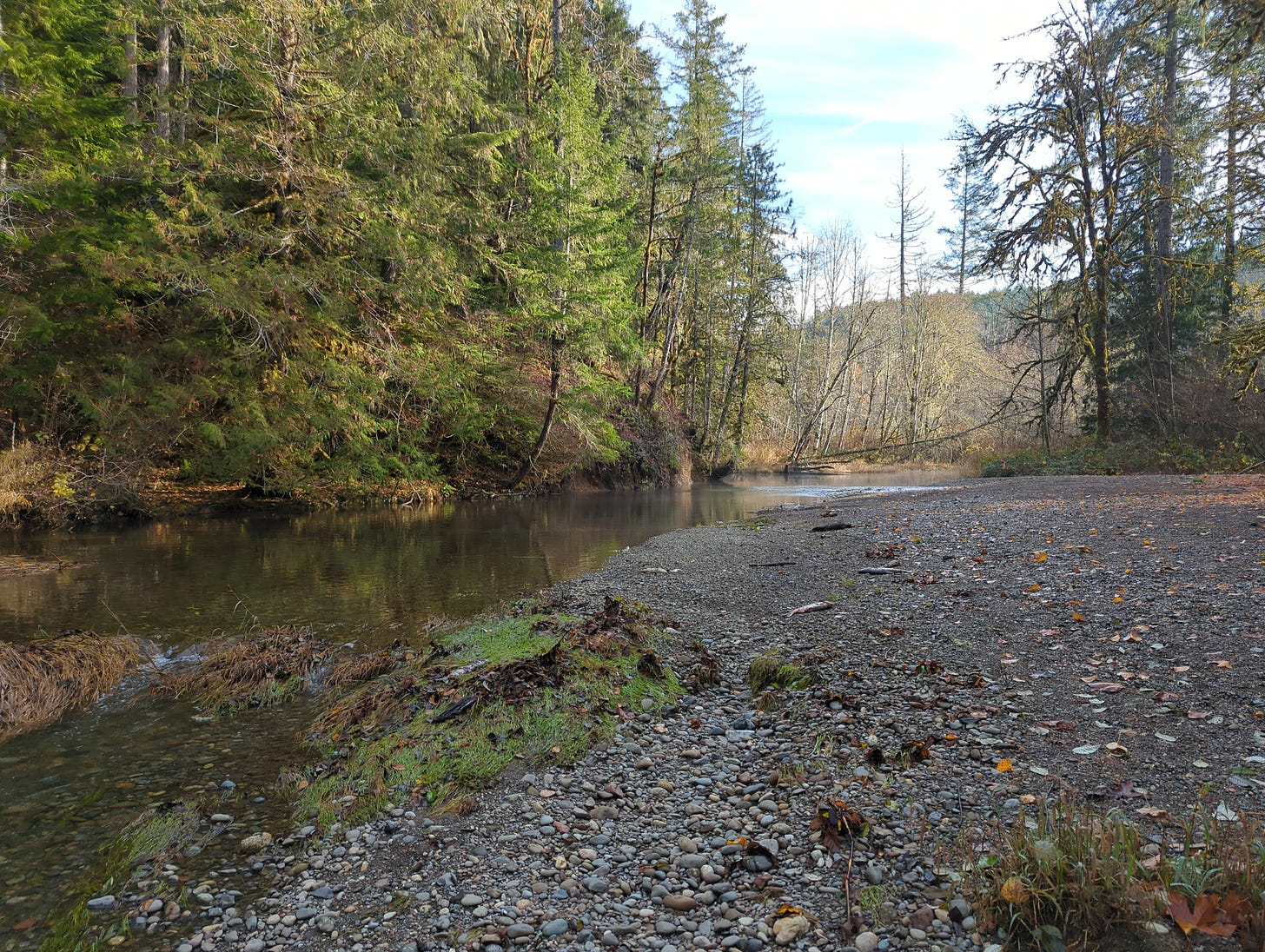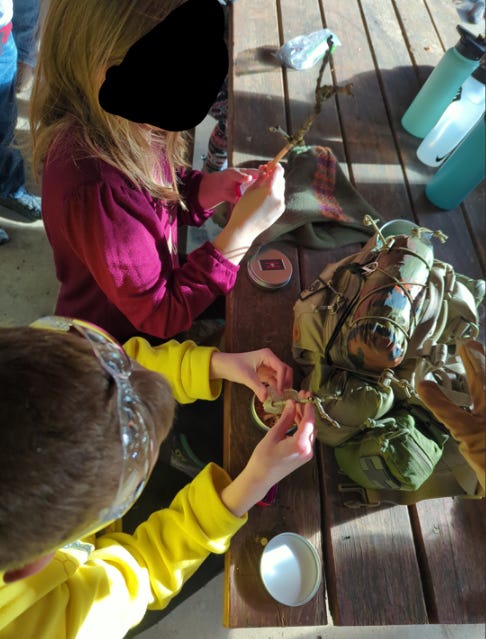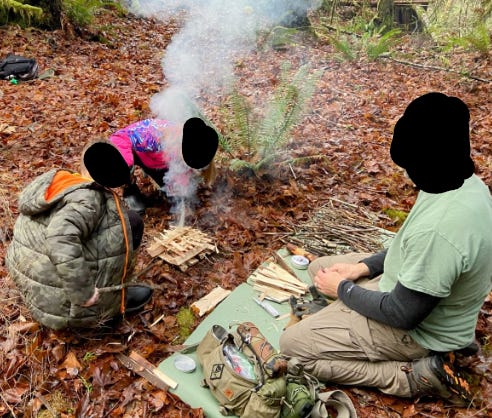There are a lot of articles and videos out there on fire craft, and this is a favorite subject of bushcraft afficionados for good reason. But as great as the latest fire starting products (or plain old Bic lighters!) are, could you start a fire in the worst conditions when all else has failed? There’s no amount of soaking that makes a ferro rod fail, you can literally pull it out of the water, wipe it off, and it will spark. So with the right skill set you can make fire in almost any situation if you know what to look for and what to do with it. And that’s what my friends at Frontline Preparedness taught on a cold and rainy November day in the woods of Dewatto WA.
The class was taught at a basic level, approachable to the novice outdoor enthusiast as well as the kids of all ages that showed up. The first task was knife safety, followed by an introduction to tinder-making.
The groups shaved fine curls of wood from materials sourced from the surrounding area, and then used pencil sharpeners to fill a tin with fine shavings that would take a spark when the time came.
The 5 elements of fire were covered:
Shelter: Are you really going to make your tinder bundle with it exposed to the rain? This is right at the top of the “Rule of 3’s” and one that is often overlooked. Fire prep in the worst circumstances is a tough task, and one that gets immeasurably harder if you are cold, wet, hungry, and scared. If it’s all on the line you need to keep the precious results of your hard work safe from the elements.
Tinder: The stuff that will take a spark and give you those first few seconds of precious flame.
Kindling: and this is really 2 things in series, the first thing to touch your flame should be very small, like a hat full of shavings whittled from this inside of a dead standing tree, or the fine dead twigs of an evergreen tree that were collected where they are protected from the weather. This will get you an initial hot burning but short lived fire that can ignite those pencil sized kindling pieces that will truly kindle the fledgling fire.
Fuel: that which you actually intend to burn for your fire to heat, cook, purify, and sustain your fire.
Base: Often overlooked but desperately needed on soft, wet, saturated ground. Those coals that are generated early in the fire will create a bed which sustains and grows the fire burning in the fuel above, or in contact with the water logged dirt, creates a column of steam that extinguishes the flames above it. Those that forget this tend to find out the hard way when their fire goes out no matter what they do just a few short minutes after getting it going.
From there the group practiced all the skills needed to produce all of the above, using ferro rods, batoning wood pieces, and ensuring everyone had the techniques needed to be successful in the woods.
A bit of rain and some very cool, damp air had moved in at this point, so it was perfect for the “final exam” of doing it for real in the woods.
We trekked up into the timber company land as a group, talking about the different fuel sources available in the environment along the way, until we reached a somewhat flat area below a mix of huge maple trees on conifers. The ground was thick with moss and the fall leaf litter, all soaked by the previous days rain. After dropping our packs at the base of the tree near where we would make our fire, the kids and I headed out to look for one of the ever present small dead standing fir trees that hide amongst the timber in this area. We located one not 20 yards from our spot, and had it cut down and dragged back within a few minutes. I started by trimming the lower spindly branches off and bundling them together on the foam sleeping pad matt I had brought along as a base to keep ourselves and our stuff protected from the damp ground. From there I cut a 7” round off the bottom and battoned it into 4 flat “shingles” to make a base for our fire. Next was another round, battoned into quarters to make the sides of the base, elevated from the surface where the fire would lay to rest the kindling over. From there another round was cut down into small wedges, from which 30 or 40 pencil sized kindling pieces could be cut and stacked. One last round for fuel pieces and we were ready to start making sparks.
The tinder took the spark surprisingly quickly, most likely because of the sap we had found and mixed into it. The fir tree twigs were easily caught with the small flame, and soon the “log cabin” of kindling was stacked above it and beginning to catch fire.
The kids had been collecting small diameter kindling sticks from places that seemed dry to them, however when they placed their hand on what they had found and then felt the kindling cut from the inside of our dead tree the difference was profound. The wood from within the tree was completely dry, even in this wet environment!
Once our log cabin had gone up in flames and the fuel pieces had been added, something hot to drink and a ‘smore was in order.
Skills like there are not only perishable, but vitally important to pass on to the next generation. Fostering self reliance in young minds is the antidote to the state supremacist mindset espoused by the regime, since doing for yourself and depending on yourself necessitates thinking for yourself, which will inevitably lead to questioning of authority. The folks at Frontline Preparedness are offering valuable skills and experiences to those in the community that are willing to separate themselves from the virtual world for an afternoon.
So if it has been a while since you have started a fire without a bottle of lighter fluid and a blowtorch, you owe it to yourself to get out and practice with these tools. You will learn something even if you are not successful, that much I can guarantee, and as the saying goes “die in training so you don’t die in real life”.











